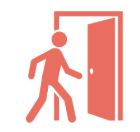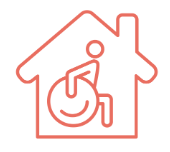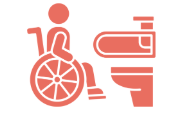8 Home Modifications
Home modifications are changes made to a living environment to improve accessibility, safety, and ease of use for people with physical limitations or disabilities. These modifications can range from simple adjustments, such as installing grab bars and removing tripping hazards, to more extensive renovations, like widening doorways, installing wheelchair ramps, or modifying bathrooms for increased accessibility. The goal of home modifications is to promote independence, enhance quality of life, and reduce the risk of injury for both people with mobility challenges and their care partners.



Identify

After being diagnosed with ALS, it’s important to think about what changes you might need in your home to promote prolonged participation in daily tasks and how much you can afford to spend. An occupational therapist can help by suggesting ways to make your home safer and easier to move around in. If you are considering big changes, like remodeling, you may also want to talk to a contractor who has experience with home accessibility.
Plan

When planning home modifications, three important needs to consider are: how you will enter and exit your home, navigate safely between rooms, and ensuring easy and secure access to the bathroom for bathing and toileting.
Entrances/Exits

If you require a wheelchair for mobility a ramp may be necessary. There are different types of ramps that can be rented, purchased, or built depending on your needs and desires.
Some things to keep in mind when installing a ramp include:
- For every inch of rise a minimum of one foot of ramp is required.
- All ramps must be at least 36 inches wide and have railings.
- There must be a solid level surface at the top and bottom of the ramp.
- If there is no entrance suitable for a ramp, a stair lift may be a better option.
Navigating in the Home

These changes can help make a home more wheelchair-friendly!
- Most wheelchairs need at least 32 inches of space to fit through a doorway. If your doorway is too narrow, you could use swing-clear hinges to make more room. Another option is to take off the door and the trim around it.
- Hallways should be at least 36 inches wide so a wheelchair can move through easily.
- To make a full circle (360 degrees) in a wheelchair, you need a clear space that is at least 5 feet across. For a half-circle (180 degrees) turn, you need at least 3 feet of clear space in each direction of the “T” shape.
Bathroom Accessibility

Bathrooms are often small with narrow doorways, making access difficult for wheelchair users. Renovating the bathroom to include more space, a roll-under sink and a zero-entry shower can help but may be expensive. Using special equipment can make bathroom access easier.
- A sliding bath transfer system works as a transfer bench for the bathtub, a roll-in shower chair, an over-the-toilet commode, and a bedside commode.
- A raised toilet seat with arms can help with toilet use.
- Installing grab bars near the toilet, shower, and bathtub improves safety. You may want to consult a contractor to ensure proper installation.
Talk to your health care team to determine the best solutions based on your needs
Summary
Home modifications help people with ALS stay safe and promote continued participation in daily activities. Widened doorways, ramps, and grab bars improve mobility and can help prevent falls. Planning ahead ensures a smoother transition as needs change throughout the disease progression. The ALS Association offers free, virtual home assessments to help you and your loved ones determine challenging areas in the home and offer recommendations about potential home modifications so you can make an informed decision.
